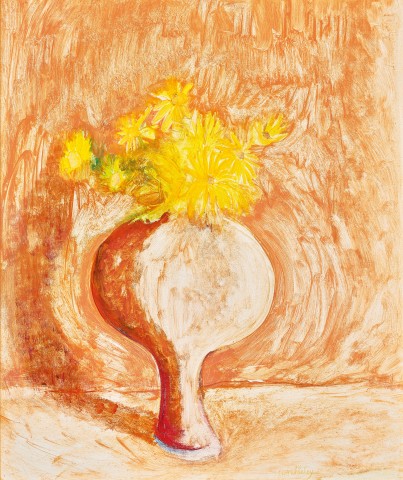DAISIES, 1975 – 76
BRETT WHITELEY
oil on canvas
65.0 x 53.0 cm
signed lower right: brett whiteley
original Lichtenstein frame
Australian Galleries, Melbourne
Barry Stern Galleries, Sydney, acquired from the above in February 1978
Private collection, Sydney, acquired from the above in 1978
Fine Paintings, Tapestries & Sculpture, Australian Galleries, Melbourne, 19 April – 3 May 1977, cat. 71
Sutherland, K., Brett Whiteley: Catalogue Raisonné, Schwartz Publishing, Melbourne, 2020, cat. 203.75, vol. 3, p. 315 (illus.), vol. 7, p. 347
When You Look at Daisies You Look at a Daisy, 1975, pen, ink and collage on paper, 59.0 x 45.0 cm, private collection, illus. in Sutherland, K., ibid., cat. 156.75, vol. 6, p. 314
‘The still life thing only became real the more I wanted to be alone… it was the furthest thing from humans – inanimate objects.’1
Exuding lyricism and sensuousness, Daisies, 1975 – 76 encapsulates well the elegant still life paintings executed by Whiteley during the mid to late seventies which – alongside his grand Matissian interiors and sparkling Sydney Harbour views – represent a highpoint in the formidable oeuvre of this revered Australian artist. Although a genre not commonly embraced by contemporary artists at the time, for Whiteley still life painting offered enormous potential – not only in compositional terms and intellectual challenge, but more poignantly, as a temporary refuge of tranquility for his famously extravagant and troubled psyche. As the artist himself mused, ‘…I see still life as an interim period in which I don’t have any ambition to paint a new subject, or to travel, or to be involved with politics. I don’t have any interest or ambition to impress or to be the last to leave a party… I am interested in a point of trying to restart, restate again… which has always been the way.’2
More modest in scale than his signature Lavender Bay panoramas and noticeably lacking in any artifice or hint of menace, arguably such compositions are among the most exquisitely beautiful of Whiteley’s myriad achievements, imbued with an endearing intimacy, calm and tangible joie de vivre. As Barry Pearce elaborates, paying ‘…tribute to a medley of artists including Bonnard and Morandi… these are the most intensely private of all his paintings, with the momentary perfection of flowers and fruit counterpoised by beads, vases and platters from the day-to-day surroundings of the family.’3 Echoing the gentle, pared-back aesthetic of Giorgio Morandi, here Daisies presents a simplicity that is both absolute and deceptive – at one level the work contains nothing but Buddhist opiate emptiness, at another, it is rich in allusions. For example, the predominantly red and yellow palette may be construed as an homage to the artist’s hero, Vincent Van Gogh, while the Derek Smith footed vase – one of the forms that Whiteley decorated so memorably in oriental blue brushwork – suggests both the bulbous shapes of the Sigean paintings and the curves of a female nude, even the hand-held mirror in the artist’s Archibald Prize-winning magnum opus from the same period, Self Portrait in the Studio, 1976. More abstractly perhaps, the vase may even be perceived as a kind of metaphorical self-portrait – an emptied head topped with a shock of yellow daisy curls.
Significantly, when eight such still lifes were first exhibited in Whiteley’s solo exhibition at Australian Galleries, Melbourne in October 1976 – together with several windowscapes, interiors and self-portraits all inspired by his Lavender Bay sanctuary – the show was universally hailed as the most accomplished success of his career. Heralding the artist’s marked departure from art as a reforming medium – from politics, social consciousness and the Rimbaudian notion of life as a contest between good and evil – towards pictures ‘…of balance, purity and serenity’4, indeed the exhibition was described by The Age critic, Maureen Gilchrist, as ‘a headlong plunge into a vision of joy’5, while even the stolid, unflappable Jeffrey Makin felt compelled to extol it as ‘outrageously brilliant’, proclaiming Whiteley ‘the only one unquestionable genius in contemporary Australian art.’6
1. The artist, cited in McGrath, S., Brett Whiteley, Bay Books, Sydney, 1979, p. 185
2. The artist, cited in Pearce, B., Brett Whiteley: Art and Life, Art Gallery of New South Wales, Sydney, 2000, p. 48
3. Ibid., p. 36
4. Matisse, cited in McGrath, op. cit., p. 181
5. Maureen Gilchrist cited in McGrath, ibid., p. 186
5. Jeffrey Makin, cited ibid.
VERONICA ANGELATOS
